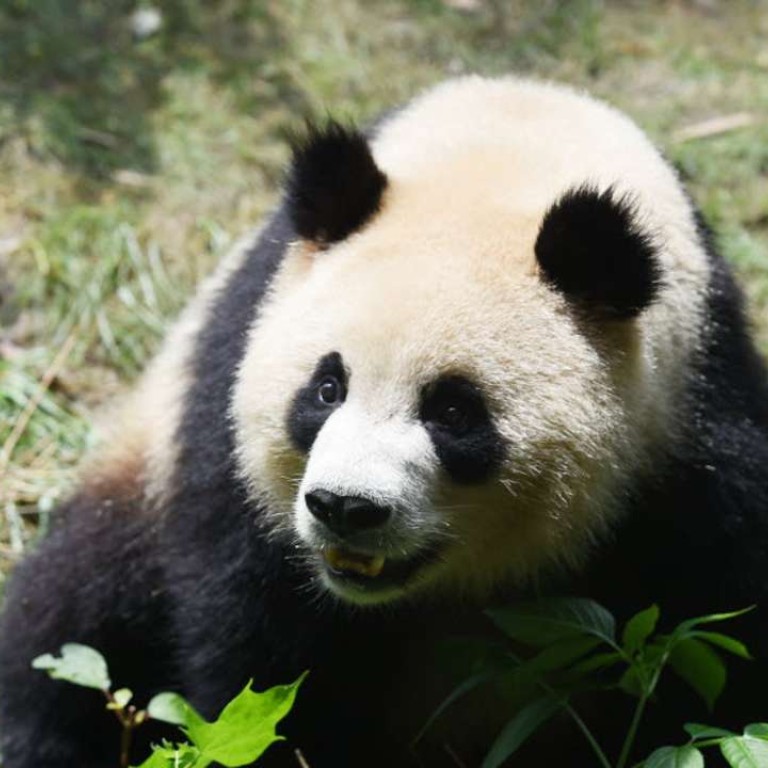
Giant pandas ‘to be deemed at lower risk level’ as population increases
Success of conservation efforts means top body on threatened species may downgrade their status from ‘endangered’ to ‘vulnerable’
The conservation status of the giant panda, China’s national treasure, could be downgraded from “endangered” to “vulnerable” as the species’ population in the wild increases, a source has told the Sunday Morning Post.
A scientific assessment of the giant panda population size and habitat commissioned by the IUCN was completed a year ago, but an official decision has yet to be made. The organisation is the leading authority on the extinction risk facing the world’s threatened species, and classifies the danger into seven categories.
Currently, the panda is deemed at high risk of dying off in the wild, although the review could see it moved down one rung, to “high risk of endangerment”, the source said.
“Scientifically, the wild population is increasing, and the natural habitat is expanding,” the source said.
The most pristine habitats are gradually being lost as roads are built into the remote mountains. Even though the overall area of habitats is expanding, we’re actually losing the best ones
The findings would be in line with China’s fourth panda censusconcluded last year. According to the State Administration of Forestry, which oversees wildlife protection, 1,864 pandas remained in the wild, with another 375 in captivity, as of the end of 2013.
The WWF said following the release of the census that panda numbers in the wild had risen nearly 17 per cent since the previous survey in 2003. This was due to forestry protection along the upper reaches of the Yangtze and Yellow rivers, as well as greater efforts to establish nature reserves. Their habitat size had also increased by 12 per cent, it said.
The IUCN, which counts more than 1,200 government and non-governmental organisations as members, did not respond to an emailed request for comment.
Lu Zhi, a professor of conservation biology at Peking University, said that although the figures appeared good, panda habitat was increasingly threatened by “fragmentation”, where intense human activities were cutting large swathes of land into smaller and more isolated patches.

“The most pristine habitat is gradually being lost as roads are built into the remote mountains. Even though the overall area of habitat is expanding, we’re actually losing the best ones,” Lu said.
“I’d hope any decision will be made very cautiously. It’s better to be conservative than regretful someday.”
The IUCN carried out an assessment of the panda’s status in 2008, and concluded the population trend was declining, citing restricted and degraded habitat as the greatest threat to the species. The giant panda was first listed as an endangered species In 1990.
The most pristine habitats are gradually being lost as roads are built into the remote mountains. Even though the overall area of habitats is expanding, we’re actually losing the best ones
The animal has a special place in Chinese culture as well as its modern-era politics. When US president Richard Nixon visited China in 1972, Beijing gave the US “Ling-Ling” and “Hsing-Hsing” to commemorate the historical visit that paved the way to full diplomatic ties in 1979.
Another pair, Tuan Tuan and Yuan Yuan, were sent to Taiwan following a breakthrough visit by a Kuomintang delegation, including its then-chairman Lien Chan.
Yet researchers at Oxford University have criticised China for such panda diplomacy, where the animals are offered in exchange for trade deals. Protection and breeding efforts at home were never made purely on conservation merits, given the political importance of the animals. But Lu pointed out that efforts to maintain their habitat had a knock-on benefit for other endangered species, such as the snub-nosed monkey and the takin, a goat- antelope, which live with them.
A change in the panda’s IUCN status is unlikely to affect China’s own conservation policies, which affords them the highest protection under the Wildlife Conservation Law.
“The ironic part is that the panda has become a de facto ‘ready source of money’ for China’s forestry authorities. But a lion’s share of the protection fund has gone to building expensive breeding centres instead of protecting habitat,” Lu said.
Habitat conservation hindered local economic development, whereas breeding centres attracted more attention and generated income, she said.
Lu was surprised to learn forestry authorities were considering new breeding centres in Beijing, Shanghai and Guangzhou.
“If the wild population is expanding, why is necessary to artificially breed pandas?” she asked.

